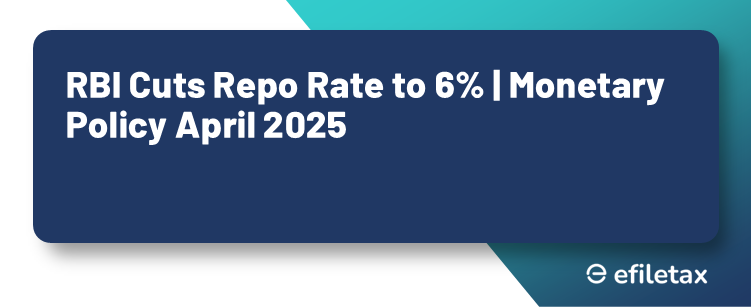
RBI Slashes Repo Rate to 6% Amid Global Uncertainty
In its 54th Monetary Policy Committee (MPC) meeting, the Reserve Bank of India (RBI) announced a 25 basis points cut, bringing the policy repo rate down to 6.00%. This marks a shift from a neutral to accommodative stance, signaling a clear pivot toward supporting economic growth amid global turbulence and falling inflation.
The move comes at a time when trade frictions and geopolitical uncertainty are weighing heavily on the global economy. According to the OECD’s Economic Outlook (March 2025), global GDP growth is forecast to moderate to 3.1% in 2025, reflecting persistent macroeconomic headwinds.
📉 Why Did RBI Cut the Repo Rate?
Inflation Trends
- CPI Inflation fell sharply from 5.2% (Dec ’24) to 3.6% (Feb ’25).
- Food inflation is at a 21-month low, supported by robust rabi and kharif crop yields.
- Crude oil prices are at a 3-year low, easing imported inflation pressures.
Growth Dynamics
- India’s GDP growth for FY 2025-26 is projected at 6.5%, a downward revision from 6.7% earlier.
- Manufacturing and agriculture sectors show signs of revival.
- Urban consumption is strengthening, with IIP consumer durables growing by 7.2% in January.
🧾 RBI’s Strategic Shift: Neutral to Accommodative
The shift to an accommodative stance implies the MPC may either:
- Hold rates steady, or
- Cut rates further, provided inflation remains under control.
“The stance signals a bias towards supporting growth, not curbing liquidity,” clarified the RBI Governor.
💹 Key Monetary Policy Announcements
| Instrument | Previous | Revised |
|---|---|---|
| Repo Rate | 6.25% | 6.00% |
| Standing Deposit Facility (SDF) | 6.00% | 5.75% |
| Marginal Standing Facility (MSF) | 6.50% | 6.25% |
| CPI Inflation Target FY26 | – | 4.0% |
📈 Growth Outlook: Sectoral Insights
- Agriculture: Foodgrain output expected to grow by 4.8% YoY; wheat and pulses production hits record highs.
- Manufacturing: Capacity utilization up to 75.3%; capital goods IIP rose 7.8%.
- Services: GST revenues up 9.9%, e-way bills rose 19.4% in Q4 FY25.
- Investment: Cement and steel consumption up over 10%, signaling infra-led demand.
💼 Implications for Business Owners & Professionals
Positive Impacts:
- Cheaper loans for MSMEs and startups
- Boost in demand for housing and consumer durables
- Stronger rupee may reduce import costs for traders
What to Watch:
- Policy changes in NBFC gold loan regulations (draft released)
- Expanded co-lending guidelines may unlock more capital for small businesses
- New securitisation framework for stressed assets under SARFAESI
📜 Legal & Policy Anchors
- RBI Act, 1934: Section 45ZB – Constitution of MPC
- SARFAESI Act, 2002: Securitisation provisions under restructuring
- Supreme Court in Small Scale Industrial Manufacturers Association v. Union of India, (2023) – Validated RBI’s wide regulatory leeway in financial stability measures
- OECD Economic Outlook, March 2025
- NSO Second Advance Estimates, 2024-25
📊 External Sector & Liquidity Snapshot
- Forex reserves: $676.3 billion (11-month import cover)
- Net FDI: $2.5 billion (lower YoY due to repatriation)
- Liquidity: ₹1.5 lakh crore surplus as of April 7, 2025
- Financial Stability: CRAR at 16.4%; GNPA at 2.42%; NBFC CRAR at 26.2%
🧠 FAQs: RBI’s April 2025 Monetary Policy
Q1: Why did RBI reduce the repo rate?
A: To support economic recovery and maintain inflation near 4%.
Q2: Will my loan EMIs reduce?
A: Yes, if your loan has a floating interest rate linked to repo.
Q3: What does an “accommodative” stance mean?
A: RBI is inclined to reduce rates or maintain status quo to support growth.
Q4: Is inflation a concern now?
A: Not immediately. Food and fuel prices are easing, and CPI is expected to average 4% in FY26.